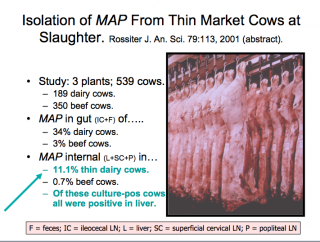Health
Is There a Cure for Crohn's Disease?
Crohn's Disease may be caused by a bacteria. It could be treated and prevented.
Posted November 10, 2013

MAP in human food
Through luck, hard work, good fortune, perseverance, and wonderful doctors, I seem to be one of the few people in the world who can claim to be “cured” of Crohn’s Disease. I’ve told this story before, in several places, but I feel a need to get the information out to a more general audience, even though this is not a psychology story but a medical and scientific one. In brief, I was treated for 6 years with medicationsn normally used for multidrug resistant TB and leprosy, under the theory that a particular germ causes Crohn's Disease. I got well, and have been entirely well since 2004. I do not follow a particular diet, and my recent colonoscopies and blood work have shown that I have no inflammation. The rest of these 3 blogs will explain more of the story.
In September, 2005, I wrote a small article for the PCC Sound Consumer, a very small newspaper published by a local Seattle natural foods grocery store, about my experience with Crohn’s Disease. http://www.pccnaturalmarkets.com/sc/0509/sc0509-hw-crohns.html For some reason, that little article went viral, and to this day I receive letters from people from all over the world asking for information about Crohn’s Disease and its probable connection with a specific microbe, mycobacterium avium subspecies paratuberculosis (MAP). I told the story again in a scientific journal, the Paratuberculosis Newsletter, http://www.paratuberculosis.info/web/images/newsletters/2012q2.pdf
But that journal is not highly visible. Since 8 years has gone by, and I have much more information now, I am going to put this on Psychology Today, for the benefit of all of those who suffer from Crohn’s or who love people who suffer from Crohn’s. I will have to tell this story in several segments, since Psych Today restricts individual posts to about 800 words. Please bear with me. I will be providing a lot of information, references, and information that is crucial to individual and public health.
There are now three blogs to read, 3 segments of my story, including my recommendations for further study and action. Part 2 is http://www.psychologytoday.com/blog/pura-vida/201311/is-there-cure-crohns-part-2 and Part 3 is http://www.psychologytoday.com/blog/pura-vida/201402/treating-crohns-disease
I will update the posts and write a blog about any new and important developments.
Please read all 3 posts before you write to me. You may certainly write or comment, but I hope that most of the basic information is covered in the 3 blogs. In particular, if you have trouble opening a link or finding them, or there is basic information that is confusing, by all means, let me know!
Single case reports are no longer the fashion in modern medicine. We all know that an n of 1 plus 1 plus 1 plus 1 ad infinitum equals nothing in terms of proving causality in “evidence based medicine”. Proving anything in the case of Crohn’s Disease is difficult. See this excellent review of this situation, Causality and gastrointestinal infections: Koch, Hill, and Crohn’s by Anne-Marie Lowe, Cedric P Yansouni, and Marcel A Behr, Lancet Infect Dis 2008:8: 720–26. You must understand that for scientists today, a single case report is virtually meaningless. However, my victory over Crohn’s Disease doesn’t prove anything by itself, but I think that it matters insofar as it suggests the desirability of pursuing a more detailed scientific inquiry. Furthermore, there are hundreds of thousands of people with Crohn’s, many of them children, who are being treated under a different paradigm, and with variable success. Moreover, I think many of those people got sick because they consumed contaminated food products without knowing it, sometimes years before the disease manifested itself. I think there is better way to treat Crohn’s, and better yet, to prevent it. In brief, I think I was “cured” of Crohn’s Disease with antibiotics directed at the eradication of Mycobacterium avium subspecies paratuberculosis.
Background: MAP is a heavy walled bacteria in the same family as leprosy and tuberculosis. In 1894, two veterinarians, Dr. H.A. Johne and Dr. L. Frothingham, identified this organism in a cow with weight loss and poor milk production in Germany. It is an acid-fast bacterium, like TB and leprosy, but has other properties as well. The best place to read about MAP is on the web site www.johnes.org
Farmers rapidly learned that their cows could develop either bovine TB or what came to be known as Johne’s Disease. Both were serious and expensive for the farmers. However, for various reasons, everyone agreed that tuberculosis could be transmitted from cows to people, and many public health measures were put into place to stop bovine TB. However, to this day, the USDA denies that MAP is a “zoonotic disease”, a disease that can be transmitted from animals to people. The ostensible reasons for this are that MAP cannot be visualized in human tissues with ordinary microscopes (while it is easy to see MAP in animal specimens); PCR studies and other DNA fingerprinting technologies yield ambiguous results; and nobody dares to try the experiment to prove Koch’s postulates, which would be to grow human MAP in culture, and then feed those germs to human infants. That would be immoral and ridiculous. For various reasons, scientists dispute the claim that MAP causes Crohn’s Disease because Koch’s postulates have not been fulfilled, even though nobody has ever grown M. Leprae (the germ that causes leprosy) in culture. It has to be grown in the foot pads of armadillos…. Leprosy is known to be causes by a specific cousin of MAP, and is managed with antibiotics. Leprosy has never been grown from humans in human media. Koch’s postulates are the old fashioned way to prove beyond a doubt that a particular germ causes a particular disease. It is not applied to viruses, prions, or other pathogens. Even though MAP comes very close to meeting Koch’s postulates, its pathogenicity is disputed. MAP can be visualized with special special microscopes. MAP is found in biopsies from patients with Crohn's. And some researchers claim that they have seen living MAP in the biopsy speciments and breast milk of Crohn's patients. However, nobody has taken identical twin human infants and fed half of them with milk and meat contaminated with MAP and fed the other half clean milk and meat products. It would be immoral! However, a scientist was able to isolate and grow MAP from human Crohn's patients, and then feed his cultures to baby goats. They did get inflammatory bowel disease.
As a result of the USDA decision, animals that test positive for MAP are not culled and eliminated from human food products. They can be sold for meat, into the food supply. This cheap meat from "downer cows" often goes into school lunch programs, because it is inexpensive. Moreover, viable MAP can be cultured from milk, including pastuerized milk, around the world. MAP is a very stubborn bacteria, resistant to heat and chlorine. It thrives on biofilms, and has a persistent spore that can last for years. The incidence of Crohn’s Disease in the world has grown in proportion to the use of dairy products. For example, Japan had little Crohn’s 100 years ago, and now it is becoming a significant problem. When you go to the grocery store and consider buying raw milk products, remember that MAP is endemic to cows, sheep, and goats, and roughly 1% of pasteurized milk in the US contains viable MAP.
Now, please go on to Part 2, https://www.psychologytoday.com/blog/pura-vida/201311/is-there-cure-crohns-part-2 Thank you.


